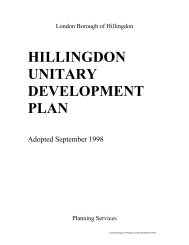Report - London Borough of Hillingdon
Report - London Borough of Hillingdon
Report - London Borough of Hillingdon
Create successful ePaper yourself
Turn your PDF publications into a flip-book with our unique Google optimized e-Paper software.
12 <strong>Hillingdon</strong> Performance Management │<br />
• Sickness absence has been identified as a significant issue and is being<br />
addressed through the provision <strong>of</strong> training, such as the Building <strong>Hillingdon</strong>'s<br />
Future programme that has resulted in reductions in sickness absence within<br />
some service areas. However the projected level <strong>of</strong> 10.1 days per staff<br />
member exceeds the target <strong>of</strong> 9 days I ;<br />
• Provision <strong>of</strong> additional resources, for example funding for the provision <strong>of</strong><br />
document scanning facilities to speed processing <strong>of</strong> benefits claims;<br />
• Departmental restructuring, for example moving Older Peoples Services from<br />
a geographical to a functional system;<br />
• 'Away days' and Planning and Performance workshops;<br />
• Reduced staff supervision ratios and defined quality management roles for<br />
supervisors;<br />
• I.T. resources to enable staff to reduce time spent in the <strong>of</strong>fice and increase<br />
time with users;<br />
• The introduction and resourcing <strong>of</strong> Quality Assurance posts.<br />
47 However recruitment and retention are still issues in some services although<br />
initiatives such as the Benefits Service Trainee Programme are having a positive<br />
impact.<br />
48 Whilst managers and staff we spoke to at focus groups were positive as to the<br />
use <strong>of</strong> performance indicators there were concerns expressed as to the long term<br />
potential danger <strong>of</strong> focussing on quantitative indicators to the detriment <strong>of</strong><br />
delivering a quality service. There was a common belief at all levels within the<br />
Council that there were too many indicators, especially at a local level where<br />
value and relevance was limited. Collecting unnecessary information adds to the<br />
burdens on staff and has the potential to divert attention from the key indicators<br />
and skew service delivery. We recommend that the Council review the range <strong>of</strong><br />
local performance indicators and remove those where the cost <strong>of</strong> data capture<br />
outweighs the value <strong>of</strong> the information provided.<br />
Impact in 'Probe' Services<br />
Planning<br />
49 The speed <strong>of</strong> processing planning applications is measured by BVPI 109a-c. The<br />
indicator differentiates performance in terms <strong>of</strong> determining major, minor and<br />
other applications. The government has set a target <strong>of</strong> 13 weeks for a major<br />
application to be determined and 8 for minor and other applications. In 2003/04<br />
43% <strong>of</strong> the Council's major applications were determined within 13 weeks. This<br />
has increased to 70% for 2004/05 placing the Council in the top performance<br />
quartile. The performance in terms <strong>of</strong> meeting the government's processing time<br />
targets for Minor and other applications placed the Council in the bottom<br />
performance quartile for 2003/04. The figures for both minor and other have now<br />
I<br />
Making a Difference - Performance Supplement<br />
<strong>London</strong> <strong>Borough</strong> <strong>of</strong> <strong>Hillingdon</strong>
















